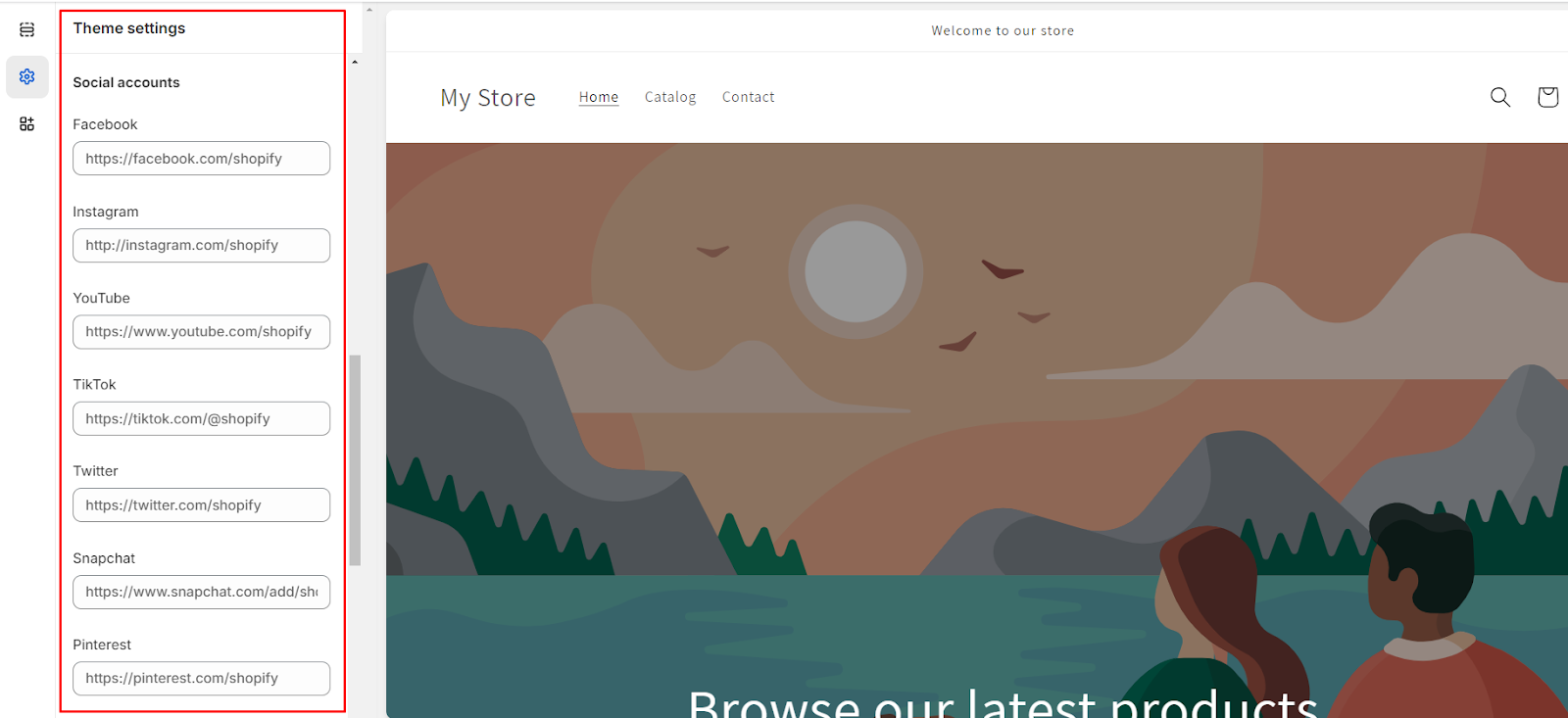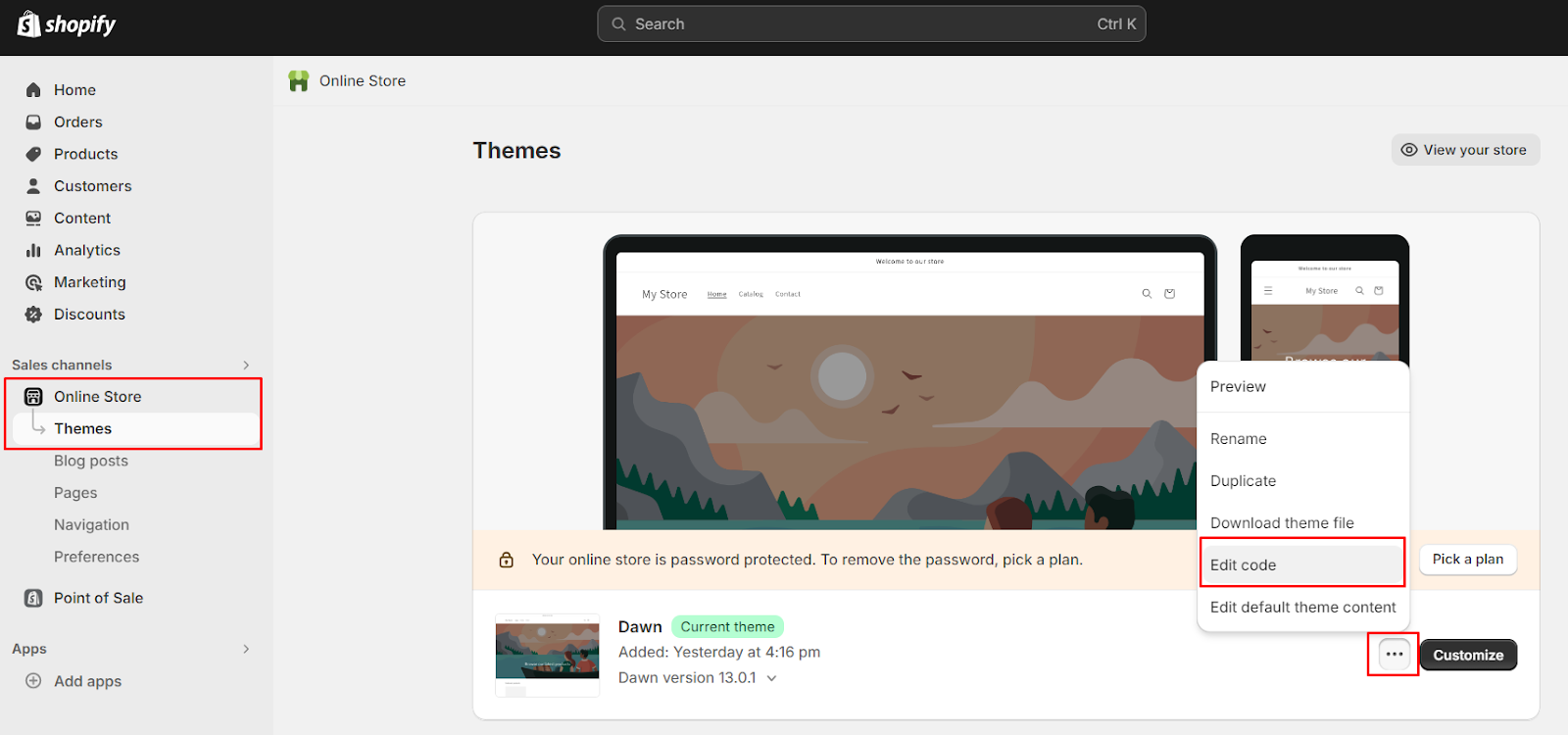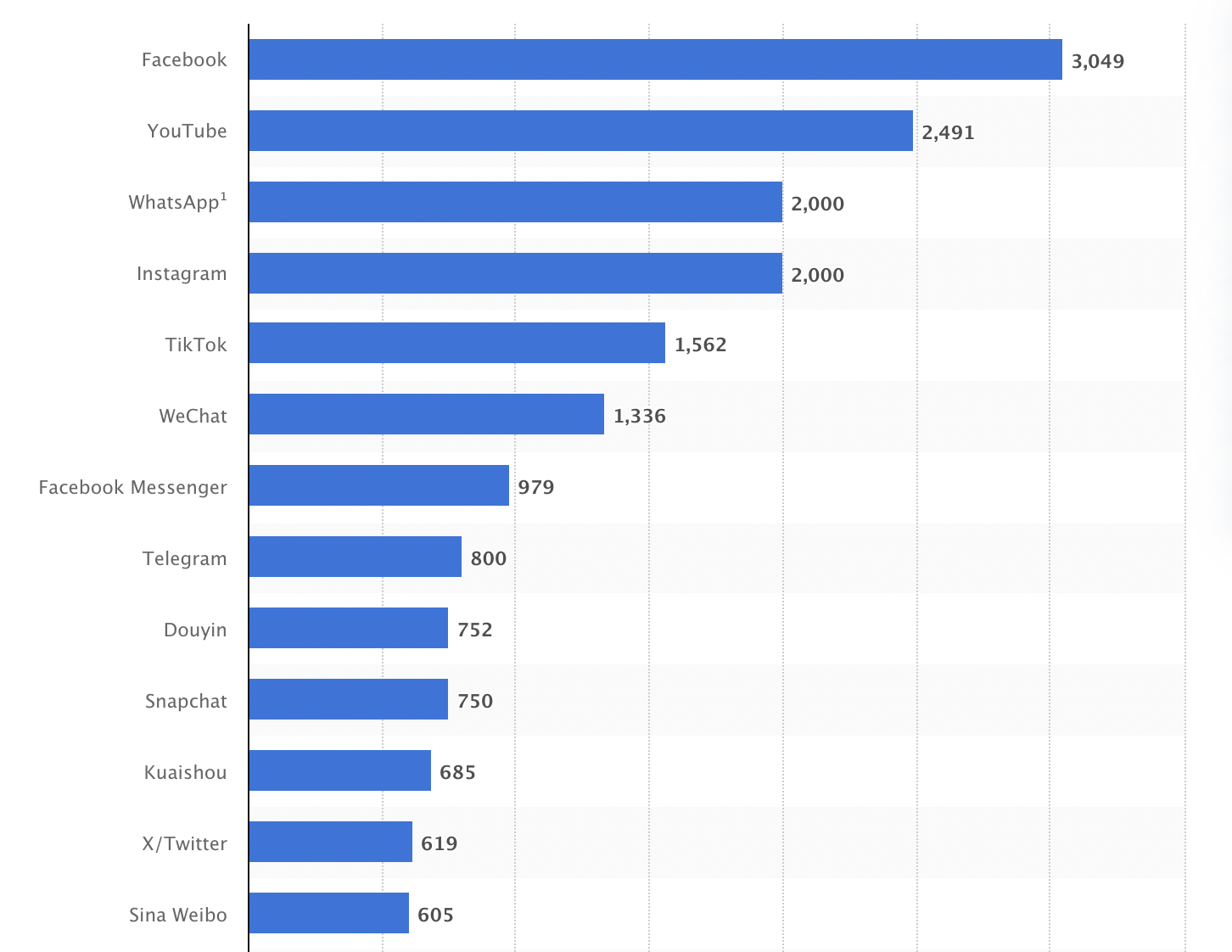Shopify Social Media Integration: Step-By-Step Guide in 2025

If you’re new to Shopify or utilizing it for your business, it’s likely that you’re already leveraging some common platforms such as Facebook or TikTok. Now, the question arises: Are you interested in elevating your social media marketing efforts or have you contemplated merging your social media profiles?
If the answer is yes, then integrating your social media accounts with your Shopify website becomes crucial. This is because, in addition to its wide range of tools and functionalities, Shopify offers seamless integration with various social networks.
This article will help you better understand the rationale behind integrating your social media accounts with your online store and the entire process of Shopify social media integration.
Benefits of Social Media Integration

When discussing the benefits of integrating social media with Shopify, numerous advantages emerge. From offering increased convenience to customers to streamlining workflows, linking your Shopify store with your social media accounts can provide you with expanded reach and efficiency, all while saving valuable time and effort.
By tapping into your existing social media following, you can target a qualified demographic more effectively. This increases the likelihood of them clicking on your links or engaging with your posts, ultimately leading to desired actions such as purchases. Additionally, integrating social media fosters a sense of community around your brand by facilitating interaction with your audience through comments, messages, or engaging posts.
Furthermore, leveraging various advertising options available on social media channels can drive sales directly to your Shopify store. Besides advertising your products and services, you can also learn from your competitors’ tactics, helping you improve your own strategies.
Create a Strategy for Social Media Integration with Shopify
Crafting a strategy for integrating your Shopify store with social media accounts is pivotal, ensuring clear objectives are outlined to achieve desired outcomes.
-
Establish Clear Social Media Goals: Clearly define what you want to achieve with social media. Do you want to increase brand visibility, drive product demand, boost website traffic, nurture a loyal customer base or foster an engaged community?
-
Understand Your Target Audience: Pinpoint your potential customer base to determine the most appropriate social media platforms. Dive into demographic details such as age, gender, and interests. Conduct comprehensive market research to understand audience preferences better.
-
Conduct a Social Media Audit: Leverage existing accounts and engagement metrics to inform your strategy. Assess performance indicators such as likes, comments, shares, follower count, and conversion rates to gauge effectiveness.
-
Develop Compelling Content: Consistency is key to building a strong online presence. Create captivating, informative, and original content that resonates with your audience. Also analyze competitors to identify opportunities for engagement and differentiation.
2 Ways to Add Social Media to Your Shopify Store
Incorporating social icons links customers to your brand across various networks. Shopify simplifies this process by seamlessly integrating icons through its theme customizer, automatically inserting buttons for allowed profiles.
Alternatively, icons can be manually added by uploading assets and inserting code. Well-placed social buttons enable visitors to easily follow your business with a single click. These icons boost engagement and provide a hassle-free means for users to connect with your brand on their preferred social platforms such as Facebook, X (Twitter), and Instagram.
By Shopify Theme Editor
Step 1: Sign in to Shopify
Begin by logging into your Shopify account using your unique log in details. After logging in, you’ll be directed to the Shopify Merchant Dashboard, your central hub for backend modifications, including domain addition and Shopify collection page creation.
Step 2: Navigate to Theme Customization
Locate the “Online Store” section in the left-hand sidebar of the Shopify Merchant Dashboard. Click on “Themes” within this section. Utilizing the Eurus Theme can expedite and simplify all steps.
Identify and click on your store’s currently published theme. You’ll find “Actions” and “Customize” buttons on the right side—click on “Customize.”

Step 3: Customize Theme
This action will redirect you to the Theme Editor, where you can make various theme adjustments. Skip other customization options and locate “Theme settings.” Click on this option to proceed.
Step 4: Manage Theme Settings
Within the Theme Editor, find and select the “Social Media” option. Here, you’ll manage settings related to integrating social media elements into your theme.
Step 5: Add Social Media Icons to Shopify
In the Social Media settings page, navigate the left sidebar until you reach the “Social Accounts” heading. Under this section, you’ll find empty text fields designated for your social media profile URLs.
Copy the URLs from your corresponding social media accounts and paste them into the respective text fields. Ensure the accuracy of the URLs before proceeding.
Once added, simply click the “Save” button located at the bottom of the editor to ensure your changes are saved. Visit your store’s URL to see the social media icons displayed at the bottom within the theme footer. Test the icons by clicking on them to confirm their functionality.
By Coding
To manually insert social media icons, coding skills are required, especially when the theme lacks automatic symbol combination features.
Step 1: Log in to Your Shopify Account
Enter your unique login credentials to access your Shopify account.
Step 2: Navigate to the Themes Section
Within your account, locate the “Online Store” section on the left side. Scroll down and select the “Themes” tab.
Step 3: Upload Social Media Assets
Navigate to the action button and select “Edit code”.

Find the “Assets” folder within the theme page, containing all visual assets. Click on it and choose “Add new asset” to upload your icon files, such as your Facebook logo in PNG format.

Step 4: Insert Icon Code
Paste the provided code snippet where you want the icon to appear in the theme code, like the footer or header. Identify the filename of the social media icon you uploaded earlier (e.g., “facebook-button.png”), then add the code below:
``````
Make sure to replace:
‘facebook-button.png’ with the actual icon asset filename ‘https://facebook.com/shopifystorepage’ with your Facebook page URL You can modify the link text (“Watching our journey on Facebook”) to suit your business.
Step 5: Save and Review
After inserting the code with the correct details, click “Save” to apply your changes. Check your live site to ensure that the social media icon is now visible, making it easy for visitors to engage with your business on Facebook. This straightforward process allows you to manually add these useful icons.
Select the Right Social Media Platforms
In today’s digital landscape, social media platforms play a vital role in any business’s marketing strategy. With a plethora of options available, selecting the most suitable platforms for your business can be daunting. In this article, we’ll delve into the advantages of integrating your Shopify store with five prominent social media platforms: Facebook, Instagram, Twitter, Pinterest, and YouTube.
Facebook Integration

Boasting 3.049 billion monthly active users as of January 2024, Facebook offers businesses a robust platform to engage with their audience. By integrating your Shopify store with Facebook, you can showcase your products, attract new customers, and drive traffic to your website. Facebook integration enables you to create a Facebook Shop, facilitating direct product browsing and purchases from your Facebook page.
Moreover, utilizing Facebook’s targeted advertising tools enables you to connect with precise audiences according to their interests, demographics, and behaviors, ultimately enhancing brand visibility and broadening your customer reach.
Instagram Integration
Renowned for its visual appeal, Instagram provides businesses with an avenue to showcase their products through captivating images and videos. Integrating your Shopify store with Instagram allows you to tap into a younger demographic and drive sales through targeted advertising. With features like shoppable posts, customers can seamlessly purchase products directly from your Instagram feed. Moreover, partnering with influencers on Instagram can further enhance brand visibility and attract new followers.
X (Twitter) Integration
Twitter’s real-time engagement capabilities make it an invaluable platform for businesses to interact with customers promptly. By integrating your Shopify store with Twitter, you can address customer inquiries, offer exclusive deals, and drive website traffic. Utilizing hashtags in tweets enhances visibility and enables you to reach users interested in your products or services. Additionally, leveraging Twitter Ads enables precise targeting to reach new customers and amplify brand awareness.
Pinterest Integration

As a visual search engine, Pinterest allows businesses to showcase products through visually appealing content. Integrating your Shopify store with Pinterest expands your audience reach, increases brand visibility, and drives website traffic.
Rich Pins provide detailed product information, simplifying the purchasing process for customers. Pinterest Ads enable targeted advertising based on interests, demographics, and behaviors, facilitating customer acquisition and brand promotion.
YouTube Integration
YouTube’s video-sharing platform offers businesses a unique opportunity to showcase products through engaging video content. Integrating your Shopify store with YouTube enables you to reach a younger demographic and drive sales through targeted advertising. Product videos aid customers in understanding your products and can enhance brand awareness. Leveraging YouTube Ads allows precise targeting to reach potential customers and amplify brand exposure.
By choosing the appropriate platforms and utilizing their unique characteristics, you can develop an effective social media strategy that yields concrete outcomes for your business.
TikTok
While the newest on the scene, TikTok has exploded in popularity thanks to its engaging format - short, entertaining videos in a never-ending scroll. This format is particularly captivating for its core user base: a young and highly active demographic. This presents a golden opportunity for e-commerce businesses targeting teens and young adults (Gen Z and Millennials). Content on TikTok often sees a much higher engagement rate compared to other platforms when reaching these younger shoppers.
TikTok boasts over 1.5 billion monthly users worldwide, solidifying its position as a major player in the social media landscape. Recognizing this potential, brands are starting to leverage TikTok for e-commerce ventures. Experts even suggest it could be the future of the industry. Regardless of the future predictions, the platform offers several valuable tools for businesses:
Popular Shopify social media integrations
It’s evident that integrating social media platforms can unlock numerous advantages, such as increased followers, impressions, awareness, and engagement.
Now, you might be pondering which social media platform to leverage for maximum impact. From Facebook and Snapchat to LinkedIn, the options are plentiful.
Let’s follow the instructions below to integrate some of the popular social media available for Shopify:
- Access your Shopify admin dashboard and go to Settings > Apps and Sales channels.
- Click on the Shopify App Store and scroll down to select Facebook, X(Twitter), Pinterest, Youtube, or TikTok to explore its features.
- Click the Add Channel button to initiate the integration process.
- Connect your social media account by selecting the Connect Account button.
- Customize your shop on social media platforms by selecting the collections, products, or images you wish to highlight.
- Agree to the terms and conditions, and then click on Finish Setup to finalize the process.
- Once set up, your shop on social media will automatically synchronize with your Shopify store.
Wrapping Up
In summary, both techniques for adding social media integration offer Shopify sellers convenient ways to enhance their promotional reach with minimal effort. The theme customizer method streamlines the process, while uploading assets allows for more personalized control. Regardless of the chosen approach, the outcome for business owners is increased discoverability and engagement opportunities across major social networks.
Integrating social media is vital for linking potential customers with shop listings, boosting sales, and nurturing communities of brand advocates. Understanding how to incorporate social media into Shopify is advantageous, providing customers with familiar avenues to follow new product launches or sales. Implementing at least one of these straightforward methods will undoubtedly elevate the visibility and connections of any online store.




